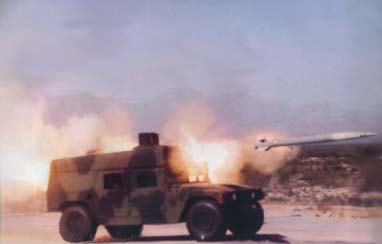LINE-OF-SIGHT ANTI-TANK MISSILE (LOSAT)

|
The Line-Of-Sight Anti-Tank Missile (LOSAT) is an anti-tank weapon system designed to provide lethal fire to defeat any known or projected armor systems at ranges greater than 4,000 meters. It uses kinetic energy as its kill mechanism and is the first of the Army's Kinetic Energy Missile programs. LOSAT, which will be mounted on a U.S. Army High Mobility Multi-Purpose Wheeled Vehicle (HMMWV) chassis, is being developed as a supplemental anti-armor capability for fielding in five light divisions currently equipped with Tube-launch Optically-controlled Wire-guided (TOW) and Javelin anti-tank systems. The basic organizational unit for LOSAT will be a five-man squad equipped with two HMMWVs and a high-mobility Missile Resupply Trailer. One HMMWV, called the Fire Unit (FU), will be the LOSAT missile launch vehicle that can carry four ready-to-fire missiles. The fire control system in the FU is based on the Improved Bradley Acquisition System, which features an acquisition system using a second-generation Forward-Looking Infrared sensor and a daylight TV. The other vehicle, the Resupply HMMWV, will tow the missile resupply trailer, which will carry eight additional missiles. The system is to be deployable by strategic (e.g., C-5, C-17) and tactical airlift (C-130), and external air transport via UH-60 and CH-47 helicopters.
BACKGROUND INFORMATION
The LOSAT program was designated as an Advanced Technology Demonstration (ATD) in 1992 and upgraded to an Advanced Concept Technology Demonstration (ACTD) in 1997. The program was restructured in 1999 to enter an Engineering and Manufacturing Development-like phase, referred to by the Program Manager as ACTD Plus, to prepare for an LRIP decision in early FY04. This LRIP decision in FY04 will be followed by IOT&E in FY05. Results of this testing will support a full-rate production decision in early FY06. In 2000, the restructured LOSAT program was designated an ACAT II program. OSD has designated LOSAT for DT&E, OT&E, and LFT&E oversight. Furthermore, LOSAT's LFT&E program will require assessments for both the vulnerability of the system (Fire Unit, Resupply Vehicle, and Resupply Trailer) and the lethality of the missile.
TEST & EVALUATION ACTIVITY
During the year, the principal test activities were two Risk Reduction Flights successfully launched from White Sands Missile Range, NM, in May and July 2001. In each test, a contractor gunner remotely launched the missile from a stationary LOSAT FU. The tested hardware included recent design innovations, including new HMMWV FU configurations and several modifications to the missile. As planned, the missile's Aft Looking Receiver and FU's laser link were not functional and, as such, there was no capability for the FU to provide position updates to the missile during the flight.
Additionally, test activities during the year included the planning of the test program, and a revised TEMP. The current draft TEMP encompasses: (1) Dismounted Battlespace Battle Lab Demonstrations to be conducted in the FY04 timeframe to examine deployability and survivability; (2) the Limited Users' Test to be conducted in FY04 should provide information to support the LRIP decision; (3) the IOT&E, comprised of live firings and force-on-force exercises, to be conducted in FY05; and (4) a combined vulnerability and lethality LFT&E strategy.
TEST & EVALUATION ASSESSMENT
All prior testing, including the two Risk Reduction flights in FY01, has been of a technical nature. Results to date indicate that the LOSAT is capable of defeating any current or projected tank it hits. Furthermore, launch effects from shock, g-load, flash, toxic gases, pressure, and sound (in and outside the vehicle) have been demonstrated to fall within the Army's acceptable ranges for human factors.
The kinetic energy missile is lethal given that it hits its intended targets. Missile firings against high-fidelity targets will confirm this against moving targets, and other configurations more difficult to hit. The survivability of the system itself is more problematic. The Army has chosen to trade-off ballistic protection of the LOSAT vehicles and trailer for enhanced deployability as part of a light early entry force. As such, to ensure that the LOSAT system remains sling-loadable from a UH-60 helicopter, the system's armor protection levels were constrained. The LFT&E program will assess the degree to which the LOSAT system, including the missile, both HMMWV vehicles, and the loaded trailer, is vulnerable to the expected threats. Extensive efforts have been taken during FY01 to develop a Live Fire Strategy for inclusion in the revised TEMP. This strategy describes critical vulnerability and lethality issues, and the scope of testing needed to address them, including the need for more than one FU for full up, system-level LFT&E to support the planned full-rate production decision in early FY06.
|
NEWSLETTER
|
| Join the GlobalSecurity.org mailing list |
|
|
|

